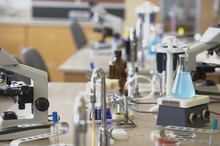What Are the Functions of Peptides?
Peptides are found throughout every cell and tissue in the body and are an integral part of most biologic processes. Maintenance of appropriate concentration and activity levels of peptides is necessary to achieve homeostasis and maintain health.
Proteins
Peptides are molecules more commonly referred to as proteins. According to the book "Principles of Biochemistry," all peptides are composed of amino acids chemically linked together. Peptides range in size from two amino acids--dipeptides--to thousands of amino acids, or polypeptides. The function of a peptide is determined by its size and amino acid sequence.
Transporters
What are the Functions of Lipid Steroids?
Learn More
All cells have a protective membrane that prevents most substances from easily passing into the cell. According to the book "Advanced Nutrition and Human Metabolism," some peptides act as transporters that selectively allow certain substances to pass into the cell through the cell membrane. For example, glucose transporters are necessary for glucose to travel from the blood into muscle or other cells to be used for energy. Similarly, cellular waste products can exit the cell through certain peptide transporters.
Enzymes
Enzymes are biologic catalysts that speed up metabolic reactions. According to "Principles of Biochemistry," most enzymes are peptides. Hundreds of enzymes are located throughout the body to speed up reactions involved in many processes. These processes include the digestion of food, production of energy and synthesis of cellular components.
Hormones
What Are the Benefits of Peptides?
Learn More
Hormones act as biologic messengers carrying information from one tissue through the blood to a distant tissue. Two common classes of hormones are peptide and steroid hormones. According to "Advanced Nutrition and Human Metabolism," examples of peptide hormones include those involved in blood glucose regulation, such as insulin and glucagon, and those that regulate appetite, such as ghrelin and leptin.
Structure
According to "Advanced Nutrition and Human Metabolism," peptides also function as structural elements of the body. For example, the peptides actin and myosin are important structural components of muscle. Peptides also contribute to bone shape and strength. Bone and muscle not only provide structure to the body, but are also involved in movement and provide protection to internal organs.
Related Articles
References
- "Principles of Biochemistry (fourth edition)"; D.L. Nelson, M.M. Cox; 2005.
- “Advanced Nutrition and Human Metabolism (fifth edition)”; S.S. Gropper, J.L. Smith, J.L. Groff; 2009
Writer Bio
Michael Crosier has been writing since 2005. His work has appeared in publications such as "Journal of the American Dietetic Association" and "Journal of Bone and Mineral Research." Crosier is an assistant professor in the Food and Nutrition Department at Framingham State College in Massachusetts. He is a registered dietitian and received his Ph.D. in nutritional biochemistry from Tufts University.







